Director(s) Kouichi Yotsui Cabinet Upright Initial release date 1989 Genre Platform game | Composer(s) Junko Tamiya Arcade system CPS-1 Designer Tokuro Fujiwara | |
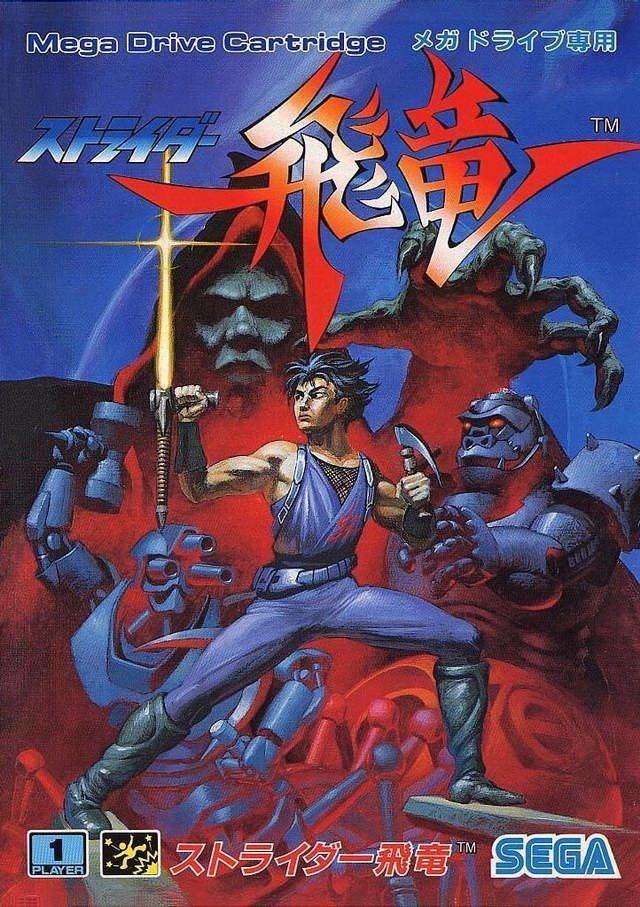 | ||
Mode(s) Single player (2-player alternating) Display Raster, 384x224 pixels (horizontal),
4096 on-screen colors,
65,536 color depth Platforms Arcade game, Sega Genesis, Master System, Wii Developers Capcom, Sega, Tiertex Design Studios Publishers Capcom, Sega, NEC, Tectoy, U.S. Gold, NEC Avenue, Ltd., SEGA of America Similar Strider 2, Marvel vs Capcom: Clash of, Captain Commando, Marvel vs Capcom 2: New Age, Ultimate Marvel vs Capcom 3 | ||
Strider, released in Japan as Strider Hiryū (ストライダー飛竜), is a 1989 side-scrolling platform game developed and released for the CP System arcade hardware by Capcom. Strider is a hack and slash platformer set in a dystopian future in the year 2048 and features a wide range of settings that dramatically affect gameplay.
Strider marked the video game debut of Hiryu, a member of a secret group of ninjas known as the “Striders” shortly after the character's 1988 debut as the main character in a manga titled Strider Hiryu.
Hiryu went on to become the main protagonist of a long-running series of video games and one of Capcom's most popular characters. The arcade game is part of a three-way cooperation between Capcom and manga publisher Moto Kikaku, which also includes a manga book and an NES video game.
Ports for the Amiga, Amstrad CPC, Atari ST, Commodore 64, DOS and ZX Spectrum were developed by Tiertex and published by U.S. Gold in 1989. Sega ported Strider to its own Genesis console in 1990 to wide acclaim. Of all home versions, the Genesis adaptation is considered the most successful, it won the 1990 Video Game of the Year and Best Graphics in a Video Game awards from Electronic Gaming Monthly and was featured in the book 1001 Video Games You Must Play Before You Die. Strider's innovative, fast-paced gameplay is cited as a major influence on several popular video game franchises such as Ninja Gaiden, Devil May Cry and God of War. It became one of Capcom's early big hits prior to Street Fighter II, hailed for its innovative gameplay, diverse and unique music, and multilingual voice samples.
Contents
- Gameplay
- Plot
- Development
- Home versions
- Reception
- NES port
- Sequels
- Remake
- Other appearances
- Related games
- Influence
- References
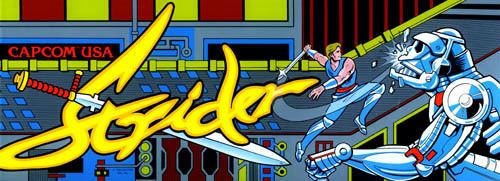
Gameplay

The controls of Strider consist of an eight-way joystick and two action buttons for attacking and jumping. The player controls the protagonist Strider Hiryu, whose main weapon is a tonfa-like plasma sword known as "Cypher". He can perform numerous acrobatic feats depending on the joystick/button combination used. Pressing the jump button while Hiryu is standing still will cause him to do a regular vertical jump, while pressing the jump button while pushing the joystick left or right will enable him to do a cartwheel jump. Hiryu can also slide under or through certain obstacles and enemies by first crouching down and then pressing the jump button. As well as his sliding move, both jumps can also be used to destroy weaker opponents. Hiryu is able to latch onto certain platforms, and climb across walls and ceilings using a metallic hook. While running down a sloped surface, Hiryu can gain enough momentum to allow him to do a longer cartwheel jump than usual.
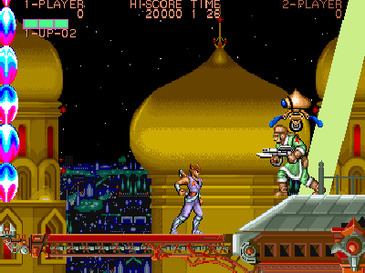
Numerous power-ups can be obtained from item boxes carried by certain enemies. These include an extension to Hiryu's attack range that lasts for one hundred slashes, two types of health aids (represented by the kanji used to write Hiryu's name: 飛 and 飛竜), a max health extension (represented by the kanji 竜, the second character in Hiryu's name), an extra life, and a power-up that not only makes Hiryu invulnerable to attack but also increases his own attack abilities via shadow images of himself for 15 seconds. Hiryu can also summon robotic companions known collectively as "options" that help him fight enemies. These consist of up to two mushroom-like droids, a saber-toothed robo tiger and a robot hawk, known individually as Options A, B and C respectively.
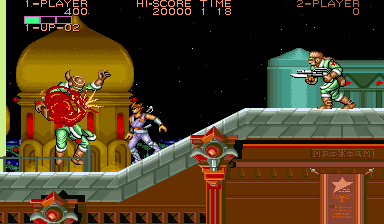
The game has five stages: the Kazakh Soviet Socialist Republic (called "St. Petersburg" during the arcade game's attract sequence), the Siberian Wilderness, the Aerial Battleship Balrog (געלראב), the Amazonian Jungle, and the Grandmaster's lair itself, the Third Moon. Each of the stages is divided into a number of smaller sections, each with their own time limit and checkpoint location. The player has a three-point health gauge (which can be increased to five points with the health extensions). Hiryu will lose a life when either his health gauge is fully depleted, by moving him off the screen entirely (like falling into a bottomless pit) or when the game's timer reaches zero. It is Game Over when all of Hiryu's lives are lost, but the player can be given the opportunity to continue.
Plot
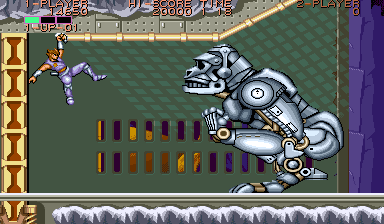
Strider is set in a dystopian future in the year 2048, where a mysterious dictator known as the "Grandmaster" rules over the world. Hiryu, the youngest ever Super A Ranked member of an organization of high-tech ninja agents known as the "Striders", is alone tasked with the Grandmaster's assassination. Hiryu begins his mission by infiltrating the Grandmaster's capital at the Kazakh Soviet Socialist Republic.
Development
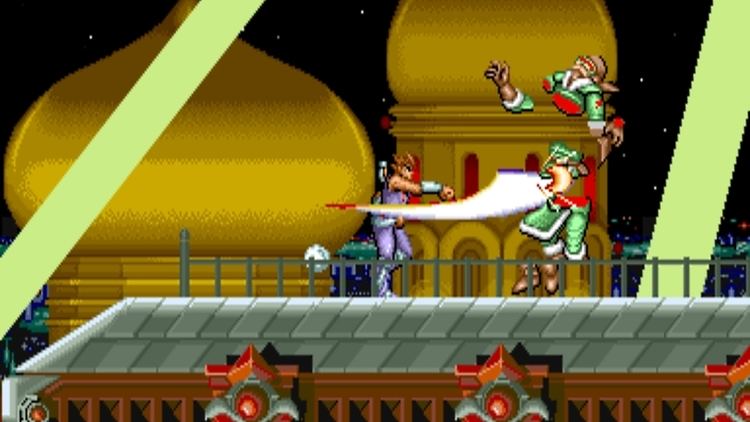
The arcade version of Strider was part of a three-way project conceived in a collaboration between Capcom and Hiroshi Motomiya's manga studio Moto Kikaku, which also included the Strider Hiryu manga by Moto Kikaku's Tatsumi Wada that was published in Kodansha's Comic Computique anthology in Japan, as well as the NES version of Strider. Kouichi Yotsui, director of the coin-op Strider (who is credited as Isuke in the game), was chosen for his experience with the CP System hardware while working as a background designer on Ghouls 'n Ghosts. The three projects were developed independently of each other.
The original arcade game soundtrack was composed entirely by female video game music composer Junko Tamiya, who was not credited for her work in the arcade version but was mentioned as part of the original arcade staff in some console adaptations. Early revisions of the arcade game were missing the unique music for the Aerial Battleship and Third Moon stages. In this version the music from the first stage of the game was repeated here instead.
Strider contains many different styles of themes that change dynamically throughout the game according to the stages and the situations on screen. These range from experimental and progressive futuristic sci-fi action themes to baroque, tribal and classical music pieces. Elements from the soundtrack have also been used in other Capcom games where Hiryu has appeared. These include the Marvel vs. Capcom series as well as other Strider related games.
Home versions
Ports of Strider for the Amiga, Amstrad CPC, Atari ST, Commodore 64, DOS, and ZX Spectrum were published by U.S. Gold and developed by Tiertex in 1989. The U.S. Gold versions has the order of the third and fourth stages swapped (the order of the cut-scenes were kept the same, causing a continuity error), and the final battle with the Grandmaster missing (the last stages ends with the battle against the giant robot gorilla Mecha Pong). As a result, the ending was changed to reveal that the events of the game were a simulation that the player was going through. All five versions featured downgraded graphics, less music and missing enemies compared to the arcade version. Additionally, the controls were modified so that the game would be compatible with one-button joystick controllers. Despite these changes, all of the U.S. Gold releases received high review scores by computer game magazines of the time. Later, in 1992, the assets of the Amiga versions were used for the conversion on the Sega Master System, also made by Tiertex. A final fight with the Grandmaster was added in this version, but the ending credits continue to say that all was just a simulation.
Sega produced their home version of Strider for the Mega Drive/Genesis, which was released in Japan on September 29, 1990, with subsequent releases in North America and the PAL region. It was advertised as one of the first 8-Megabit cartridges for the system, and went on to be a bestseller. This version was also re-released for the Wii Virtual Console in Japan on November 15, 2011 and later in North America on February 16, 2012. The Genesis/Mega Drive version contains a different ending from the arcade game. This ending shows the destruction of the final stage as the game's protagonist makes good his escape. This is then followed by the main credit sequence that sees Hiryu flying his glider in space and reminiscing about the various encounters he had during his mission as he heads back to earth. The ending theme was an edited combination of two separate pieces of music planned for the arcade game, but replaced with a repeat of the first level music. Computer magazine ACE considered the previous Amiga conversion to be "as good as this one".
Capcom separately produced a version for the Sharp X68000 computer in 1991, releasing it exclusively in Japan. It is a very close reproduction of the arcade original, with minimal changes.
NEC Avenue produced a PC Engine version of Strider Hiryu, which was released exclusively in Japan on September 22, 1994. The PC Engine version was released as a CD-ROM² title which requires the Arcade Card expansion. The PC Engine port features an all-new desert stage that was not in the arcade version, as well as newly recorded cut-scenes, music and dialogue, with Japanese voice actor Kaneto Shiozawa as the voice of Hiryu and Kōji Totani as the Grand Master. The PC Engine version is notable for its long development process, having been planned in various formats, including the ill-fated SuperGrafx at one point.
The PlayStation version of Strider was first released by Capcom in 2000 as a second disc which came packaged with the PlayStation version of Strider 2. The North American release has the Strider and Strider 2 game code pressed onto the wrong disc. This version was reissued separately in Japan on October 24, 2006 as part of the Capcom Game Books series, which included an extended manual and strategy guide for the game.
The original arcade version was included in the 2006 video game compilations Capcom Classics Collection: Remixed for the PlayStation Portable and Capcom Classics Collection Vol. 2 for the PlayStation 2 and Xbox. A Japanese mobile phone version was released in 2010.
Reception
Upon its release, EGM was impressed with the Genesis port, devoting portions of three separate issues to it, awarding it with best video game of the year in 1990 and winner of their best graphics category. In 1992, Mega placed Strider at 31st spot in their list of top Mega Drive games of all time.
Strider has remained fondly remembered for years, having spawned numerous fansites and retrospectives. In 2010, UGO.com included Strider in their list of the 25 video games that need sequels, and Game Informer included it on the list of ten gaming franchises that should be revived: "Imagine the sidescrolling insanity of the Metal Slug series, but replace grizzled soldiers with a badass ninja. That's Strider, and it's awesome." That same year, the game was also included as one of the titles in the book 1001 Video Games You Must Play Before You Die. ScrewAttack named it as the best Genesis game ever made, and Retro Gamer included it among the top ten Mega Drive games.
According to Retro Gamer's Darran Jones, "everything about Strider was epic. Its backgrounds were brilliantly designed and featured an array of exotic locations, while its sprite design was superb. There was a uniqueness to Strider art design that gave it a distinctive look back in 1989 and still makes it stand out brilliantly today. Its a mysterious mish-mash of different cultures that ensured it stood out from its arcade peers." Jones also praised the game's "stunning animation", gameplay, and controls, as well as its "superbly atmospheric" soundtrack.
NES port
Strider was released for the NES exclusively in North America a few months after the arcade version's release. This version was produced alongside the arcade game but follows the plot of Moto Kikaku's tie-in manga. A Famicom version of the same game was planned for release in Japan, but never made it to the shelves.
Sequels
Under license from Capcom U.S.A., U.S. Gold and Tiertex produced a Strider sequel in Europe titled Strider II (released in North America as Journey From Darkness: Strider Returns) for various computer platforms, as well as the Sega Genesis/Mega Drive, Game Gear, and Master System home consoles. This European-produced sequel was not released in Japan. Like the previous conversions of the original game, the quality of this one was very low. Capcom later produced another sequel, unrelated to the Tiertex-produced Strider Returns, titled Strider 2, which was released for the arcades and the PlayStation in 2000.
Remake
An untitled Strider reboot game was being developed by Grin in 2009, before being canceled by Capcom, soon after Bionic Commando was released. An all-new Strider remake was developed by Double Helix Games and released on PlayStation Network for the PlayStation 3 and PlayStation 4, Xbox Live Arcade for the Xbox 360 and Xbox One, and Steam in 2014.
Other appearances
Strider Hiryu also appears as a playable character in the 1998 fighting game Marvel vs. Capcom: Clash of Super Heroes, which was followed by Marvel vs. Capcom 2: New Age of Heroes in 2000. Hiryu has also made appearances in other Capcom-produced games such as SNK vs. Capcom: Card Fighters Clash, Namco × Capcom and Adventure Quiz: Capcom World 2. Hiryu was one of the characters intended to appear in the unreleased 3D fighting game Capcom Fighting All-Stars. Hiryu's latest guest appearance was in the 2011 fighting game Ultimate Marvel vs. Capcom 3 which marked his characters official 3D debut; this game is also notable as being the first where he is voiced in English.
Related games
Strider director Kouichi Yotsui left Capcom soon after its release. He later designed an unofficial, coin-operated sequel for Mitchell Corporation in 1996. Yotsui considers that game, titled Cannon-Dancer in Japan and Osman in the West, a "self-parody" of his work on Strider. Moon Diver is a 2011 Square Enix game that shares some of the same gameplay elements and was also created by Yotsui.
Influence
According to Eurogamer, Strider was a vital influence on video game franchises such as Devil May Cry, Ninja Gaiden and God of War. British rapper Tinchy Stryder named himself partially after Strider, which he often played as a boy. On October 2012, Brazilian guitarist Pedro Pimentel releasead a tribute theme to this game series - also named "Strider" and included in his debut solo album (self-tilted). As published in the Brazilian edition of Guitar Player magazine (March 2013), "'Strider' is a composition with a very modern theme and great guitar solos. Good quality recording and very tasteful tones.".
